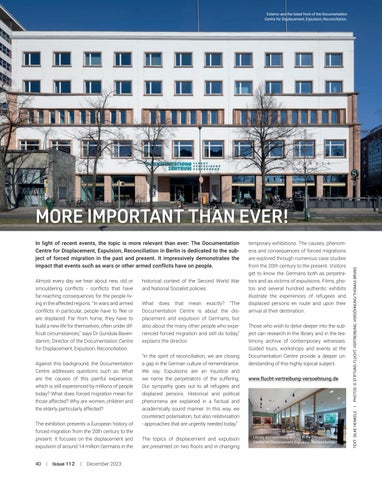Exterior and the listed front of the Documentation Centre for Displacement, Expulsion, Reconciliation.
Against this background, the Documentation Centre addresses questions such as: What are the causes of this painful experience, which is still experienced by millions of people today? What does forced migration mean for those affected? Why are women, children and the elderly particularly affected? The exhibition presents a European history of forced migration from the 20th century to the present. It focuses on the displacement and expulsion of around 14 million Germans in the 40
|
Issue 11 2
|
December 2023
historical context of the Second World War and National Socialist policies. What does that mean exactly? "The Documentation Centre is about the displacement and expulsion of Germans, but also about the many other people who experienced forced migration and still do today," explains the director. "In the spirit of reconciliation, we are closing a gap in the German culture of remembrance. We say: Expulsions are an injustice and we name the perpetrators of the suffering. Our sympathy goes out to all refugees and displaced persons. Historical and political phenomena are explained in a factual and academically sound manner. In this way, we counteract polarisation, but also relativisation - approaches that are urgently needed today.” The topics of displacement and expulsion are presented on two floors and in changing
Those who wish to delve deeper into the subject can research in the library and in the testimony archive of contemporary witnesses. Guided tours, workshops and events at the Documentation Centre provide a deeper understanding of this highly topical subject. www.flucht-vertreibung-versoehnung.de
I
Almost every day we hear about new, old or smouldering conflicts - conflicts that have far-reaching consequences for the people living in the affected regions. "In wars and armed conflicts in particular, people have to flee or are displaced. Far from home, they have to build a new life for themselves, often under difficult circumstances," says Dr Gundula Bavendamm, Director of the Documentation Centre for Displacement, Expulsion, Reconciliation.
temporary exhibitions. The causes, phenomena and consequences of forced migrations are explored through numerous case studies from the 20th century to the present. Visitors get to know the Germans both as perpetrators and as victims of expulsions. Films, photos and several hundred authentic exhibits illustrate the experiences of refugees and displaced persons en route and upon their arrival at their destination.
Library and testimony archive in the Documentation Centre for Displacement, Expulsion, Reconciliation.
TEXT: SILKE HENKELE
In light of recent events, the topic is more relevant than ever: The Documentation Centre for Displacement, Expulsion, Reconciliation in Berlin is dedicated to the subject of forced migration in the past and present. It impressively demonstrates the impact that events such as wars or other armed conflicts have on people.
PHOTOS: © STIFTUNG FLUCHT, VERTREIBUNG, VERSÖHNUNG/THOMAS BRUNS
MORE IMPORTANT THAN EVER!
